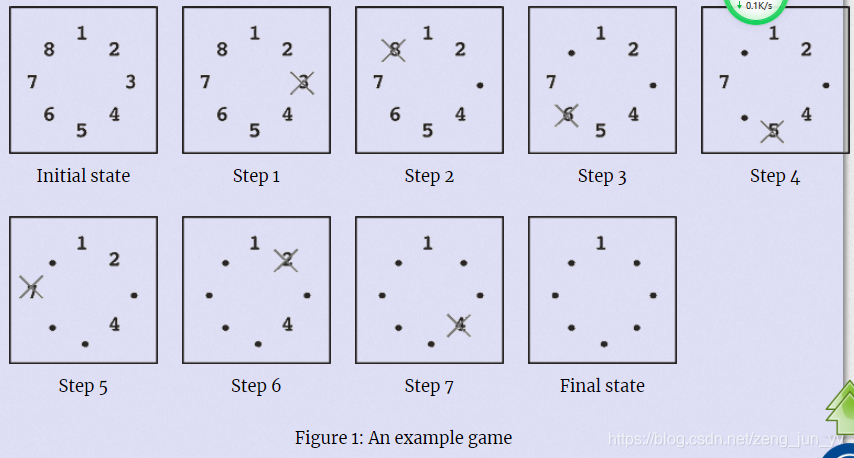题意:
约瑟夫问题的变式。先指定第m个人必须死,然后每隔k个人死一个。求最后那个死的人的编号是什么。
题目
Let’s play a stone removing game.
Initially, n stones are arranged on a circle and numbered 1, …, n clockwise (Figure 1). You are also given two numbers k and m. From this state, remove stones one by one following the rules explained below, until only one remains. In step 1, remove stone m. In step 2, locate the k-th next stone clockwise from m and remove it. In subsequent steps, start from the slot of the stone removed in the last step, make k hops clockwise on the remaining stones and remove the one you reach. In other words, skip (k − 1) remaining stones clockwise and remove the next one. Repeat this until only one stone is left and answer its number. For example, the answer for the case n = 8, k = 5, m = 3 is 1, as shown in Figure 1.

Initial state: Eight stones are arranged on a circle.
Step 1: Stone 3 is removed since m = 3.
Step 2: You start from the slot that was occupied by stone 3. You skip four stones 4, 5, 6 and 7 (since k = 5), and remove the next one, which is 8.
Step 3: You skip stones 1, 2, 4 and 5, and thus remove 6. Note that you only count stones that are still on the circle and ignore those already removed. Stone 3 is ignored in this case.
Steps 4–7: You continue until only one stone is left. Notice that in later steps when only a few stones remain, the same stone may be skipped multiple times. For example, stones 1 and 4 are skipped twice in step 7.
Final State: Finally, only one stone, 1, is on the circle. This is the final state, so the answer is 1.
Input
The input consists of multiple datasets each of which is formatted as follows.
n k m
The last dataset is followed by a line containing three zeros. Numbers in a line are separated by a single space. A dataset satisfies the following conditions.
2 ≤ n ≤ 10000, 1 ≤ k ≤ 10000, 1 ≤ m ≤ n
The number of datasets is less than 100.
Output
For each dataset, output a line containing the stone number left in the final state. No extra characters such as spaces should appear in the output.
Sample Input
8 5 3
100 9999 98
10000 10000 10000
0 0 0
Sample Output
1
93
2019
分析
首先不考虑第一个必须死的人是m的情况。我们把n个人编号为[0,n-1]。那么第一轮出局的就是编号为k-1的人,剩下的人的编号是[0,k−2]∪[k,n−1]。然后我们从编号为k的人开始,循环一圈给所有人重新分配编号
0----->i
1----->i+1
2----->i+2
… …
k-2----->n-2
k-1(杀死)
k----->0///倒推,从这里最容易看出来dp[i]=(dp[i-1]+k)%i;(此时i==n)
k+1----->1
… …
n-2----->i-2
n-1----->i-1
其实这个问题就是问如何用存活者在i-1个人中的编号求出存活者在i个人中的编号。我们知道,从原问题推到子问题其实是把所有人的编号-k,那么从子问题推到原问题就是把人的编号+k,但要注意,此时+k可能会大于当前人的规模i,所以要对i取膜。
AC代码
#include<stdio.h>
#include<string.h>
#include<algorithm>
using namespace std;
const int M=1e4+10;
int dp[M];
int n,m,k;int main()
{while(~scanf("%d%d%d",&n,&k,&m)&&(m||n||k)){memset(dp,0,sizeof(dp));for(int i=2;i<n;i++)dp[i]=(dp[i-1]+k)%i;dp[n]=(dp[n-1]+m)%n;printf("%d\n",dp[n]+1);}return 0;
}

![[C++11]decltype类型推导规则](http://pic.xiahunao.cn/[C++11]decltype类型推导规则)

)
)
![[C++11]decltype在泛型编程中的使用举例](http://pic.xiahunao.cn/[C++11]decltype在泛型编程中的使用举例)


![[PAT乙级]1031 查验身份证](http://pic.xiahunao.cn/[PAT乙级]1031 查验身份证)
)
![[PAT乙级]1032 挖掘机技术哪家强](http://pic.xiahunao.cn/[PAT乙级]1032 挖掘机技术哪家强)


)
![[C++11]返回值类型后置](http://pic.xiahunao.cn/[C++11]返回值类型后置)


)
)
